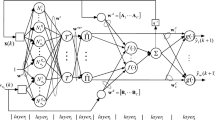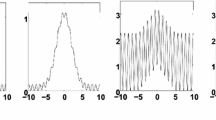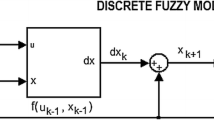Abstract
This paper considers the nonlinear system identification and control for flexible servomechanisms. A multi-step-ahead recurrent neuro-fuzzy model consisting of local linear ARMA (autoregressive moving average) models with bias terms is suggested for approximating the dynamic behavior of a servomechanism including the effects of flexibility and friction. The RLS (recursive least squares) algorithm is adopted for obtaining the optimal consequent parameters of the rules. Within each fuzzy operating region, a local MDPP (minimum degree pole placement) control law with integral action can be constructed based on the estimated local model. Then a fuzzy controller composed of these local MDPP controls can be easily constructed for the servomechanism. The techniques are illustrated using computer simulations.
Similar content being viewed by others
References
Åström, K. J., Hagander, P., and Sternby, J.: Zeros of sampled systems, Automatica 20 (1984), 31–38.
Åström, K. J. and Wittenmark, B.: Adaptive Control, 2nd edn, Addison-Wesley, Reading, MA, 1995.
Canudas de Wit, C., Olsson, H., Åström, K. J., and Lischinsky, P.: A new model for control of systems with friction, IEEE Trans. Automat. Control 40(3) (1995), 419–425.
Cartinhour, J.: Digital Signal Processing: An Overview of Basic Principles, Prentice-Hall, Englewood Cliffs, NJ, 2000.
Lin, L. C. and Lin, Y. J.: Fuzzy-enhanced adaptive control for flexible drive systems with friction using genetic algorithms, J. Intelligent Robotic Systems 23(2–4) (1998), 379–405.
Lin, L. C. and Lee, G. Y.: Hierarchical fuzzy control for C-axis of CNC turning centers using genetic algorithms, J. Intelligent Robotic Systems 25(3) (1999), 255–275.
Mandic, D. P. and Chambers, J. A.: Recurrent Neural Networks for Prediction: Learning Algorithms, Architectures and Stability, Wiley, Chichester, England, 2001.
Nerrand, O., Roussel-Ragot, P., Urbani, D., Personnaz, L., and Dreyfus, G.: Training recurrent neural networks: why and how? An illustration in dynamical process modeling, IEEE Trans. Neural Networks 5(2) (1994), 178–184.
Oppenheim, A. V. and Schafer, R.W.: Discrete-Time Signal Processing, 2nd edn, Prentice-Hall, Englewood Cliffs, NJ, 1999.
Passino, K. M. and Yurkovich, S.: Fuzzy Control, Addison-Wesley, Reading, MA, 1998.
Takagi, T. and Sugeno, M.: Fuzzy identification of systems and its application to modeling and control, IEEE Trans. Systems Man Cybernet. 15(1) (1985), 116–132.
Tanaka, K. and Wang H. O.: Fuzzy Control Systems Design and Analysis: A Linear Matrix Inequality Approach, Wiley-Interscience, New York, 2001.
Wang, L. X.: A Course in Fuzzy Systems and Control, Prentice-Hall, Englewood Cliffs, NJ, 1997.
Yen, J. and Langari, R.: Fuzzy Logic: Intelligence, Control, and Information, Prentice-Hall, Englewood Cliffs, NJ, 1999.
Zhang, J. and Morris, A. J.: Recurrent neuro-fuzzy networks for nonlinear process modeling, IEEE Trans. Neural Networks 10(2) (1999), 313–326.
Author information
Authors and Affiliations
Rights and permissions
About this article
Cite this article
Lin, CS., Yang, T., Jou, YC. et al. Recurrent Neuro-Fuzzy Modeling and Fuzzy MDPP Control for Flexible Servomechanisms. Journal of Intelligent and Robotic Systems 38, 213–235 (2003). https://doi.org/10.1023/A:1027339220324
Issue Date:
DOI: https://doi.org/10.1023/A:1027339220324




